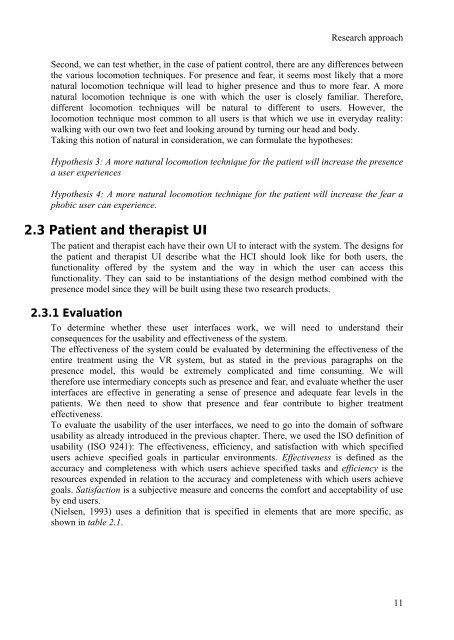Human-Computer Interaction and Presence in Virtual Reality
Human-Computer Interaction and Presence in Virtual Reality
Human-Computer Interaction and Presence in Virtual Reality
Create successful ePaper yourself
Turn your PDF publications into a flip-book with our unique Google optimized e-Paper software.
Research approach<br />
Second, we can test whether, <strong>in</strong> the case of patient control, there are any differences between<br />
the various locomotion techniques. For presence <strong>and</strong> fear, it seems most likely that a more<br />
natural locomotion technique will lead to higher presence <strong>and</strong> thus to more fear. A more<br />
natural locomotion technique is one with which the user is closely familiar. Therefore,<br />
different locomotion techniques will be natural to different to users. However, the<br />
locomotion technique most common to all users is that which we use <strong>in</strong> everyday reality:<br />
walk<strong>in</strong>g with our own two feet <strong>and</strong> look<strong>in</strong>g around by turn<strong>in</strong>g our head <strong>and</strong> body.<br />
Tak<strong>in</strong>g this notion of natural <strong>in</strong> consideration, we can formulate the hypotheses:<br />
Hypothesis 3: A more natural locomotion technique for the patient will <strong>in</strong>crease the presence<br />
a user experiences<br />
Hypothesis 4: A more natural locomotion technique for the patient will <strong>in</strong>crease the fear a<br />
phobic user can experience.<br />
2.3 Patient <strong>and</strong> therapist UI<br />
The patient <strong>and</strong> therapist each have their own UI to <strong>in</strong>teract with the system. The designs for<br />
the patient <strong>and</strong> therapist UI describe what the HCI should look like for both users, the<br />
functionality offered by the system <strong>and</strong> the way <strong>in</strong> which the user can access this<br />
functionality. They can said to be <strong>in</strong>stantiations of the design method comb<strong>in</strong>ed with the<br />
presence model s<strong>in</strong>ce they will be built us<strong>in</strong>g these two research products.<br />
2.3.1 Evaluation<br />
To determ<strong>in</strong>e whether these user <strong>in</strong>terfaces work, we will need to underst<strong>and</strong> their<br />
consequences for the usability <strong>and</strong> effectiveness of the system.<br />
The effectiveness of the system could be evaluated by determ<strong>in</strong><strong>in</strong>g the effectiveness of the<br />
entire treatment us<strong>in</strong>g the VR system, but as stated <strong>in</strong> the previous paragraphs on the<br />
presence model, this would be extremely complicated <strong>and</strong> time consum<strong>in</strong>g. We will<br />
therefore use <strong>in</strong>termediary concepts such as presence <strong>and</strong> fear, <strong>and</strong> evaluate whether the user<br />
<strong>in</strong>terfaces are effective <strong>in</strong> generat<strong>in</strong>g a sense of presence <strong>and</strong> adequate fear levels <strong>in</strong> the<br />
patients. We then need to show that presence <strong>and</strong> fear contribute to higher treatment<br />
effectiveness.<br />
To evaluate the usability of the user <strong>in</strong>terfaces, we need to go <strong>in</strong>to the doma<strong>in</strong> of software<br />
usability as already <strong>in</strong>troduced <strong>in</strong> the previous chapter. There, we used the ISO def<strong>in</strong>ition of<br />
usability (ISO 9241): The effectiveness, efficiency, <strong>and</strong> satisfaction with which specified<br />
users achieve specified goals <strong>in</strong> particular environments. Effectiveness is def<strong>in</strong>ed as the<br />
accuracy <strong>and</strong> completeness with which users achieve specified tasks <strong>and</strong> efficiency is the<br />
resources expended <strong>in</strong> relation to the accuracy <strong>and</strong> completeness with which users achieve<br />
goals. Satisfaction is a subjective measure <strong>and</strong> concerns the comfort <strong>and</strong> acceptability of use<br />
by end users.<br />
(Nielsen, 1993) uses a def<strong>in</strong>ition that is specified <strong>in</strong> elements that are more specific, as<br />
shown <strong>in</strong> table 2.1.<br />
11
















